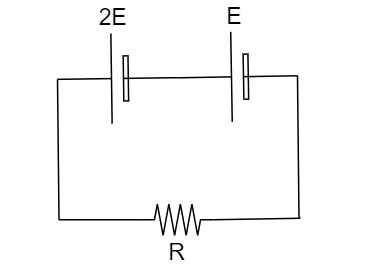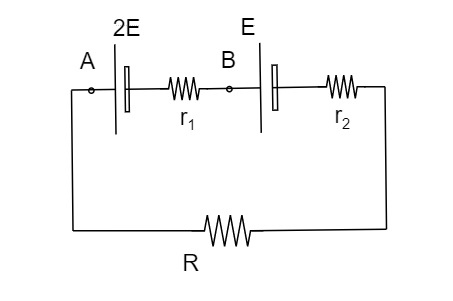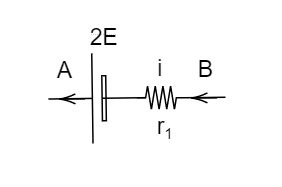
Two cells of emf 2E and E with internal resistance r1 and r2 respectively are connected in series to an external resistor R (as shown in the circuit). What is the value of R, at which the potential difference across the terminals of the first cell becomes zero?

A. \[{r_1} - {r_2}\]
B. \[{r_1} + {r_2}\]
C. \[\dfrac{{{r_1}}}{2} + {r_2}\]
D. \[\dfrac{{{r_1}}}{2} - {r_2}\]
Answer
217.2k+ views
Hint: Before we proceed into the problem, it is important to know the definition of potential difference and internal resistance. Potential difference is defined as the difference of the electrical potential between the two points. The internal resistance opposes the flow of current offered by the cells and batteries themselves resulting in the generation of heat.
Formula Used:
\[i = \dfrac{{3E}}{{R + {r_1} + {r_2}}}\]
Where, E is the emf of the cell, R is the external resistor, $r_1$ and $r_2$ are the internal resistances of the cells.
Complete step by step solution:
Now let us solve the problem step by step considering the definition.

Image: Two cells connected in series with the resistor R.

Image: The potential difference across the terminals of the first cell.
By applying the KVL for the given circuit we get,
\[ + 2E - iR - i{r_2} + E - i{r_1} = 0\]
\[\Rightarrow 3E = i({r_1} + {r_2} + R)\]
\[ \Rightarrow i = \dfrac{{3E}}{{R + {r_1} + {r_2}}}\]…….. (1)
In order to find the R value, they have given that the potential difference between point A and B is zero i.e.,
By the circuit we can write the potential difference between the point A and B as,
\[{V_A} - 2E + i{r_1} - {V_B} = 0\]
\[\Rightarrow {V_A} - {V_B} = 2E - i{r_1}\]
\[ \Rightarrow 2E = i{r_1}\]……. (2) Since \[{V_A} - {V_B} = 0\]
Now substituting equation (1) in (2) we get,
\[2E = \dfrac{{3E}}{{R + {r_1} + {r_2}}} \times {r_1}\]
\[\Rightarrow 2R + 2{r_1} + 2{r_2} = 3{r_1}\]
\[\Rightarrow R = \dfrac{{{r_1}}}{2} - {r_2}\]
Therefore, the value of \[R = \dfrac{{{r_1}}}{2} - {r_2}\]
Hence, Option D is the correct answer.
Note: Suppose if two or more cells are connected in parallel having the same emf, then the resultant emf will be equal to the emf of any one of the cells. If the cells are of different emfs, then the resultant emf will be equal to the emf of the cell which is having the greater value of emf.
Formula Used:
\[i = \dfrac{{3E}}{{R + {r_1} + {r_2}}}\]
Where, E is the emf of the cell, R is the external resistor, $r_1$ and $r_2$ are the internal resistances of the cells.
Complete step by step solution:
Now let us solve the problem step by step considering the definition.

Image: Two cells connected in series with the resistor R.

Image: The potential difference across the terminals of the first cell.
By applying the KVL for the given circuit we get,
\[ + 2E - iR - i{r_2} + E - i{r_1} = 0\]
\[\Rightarrow 3E = i({r_1} + {r_2} + R)\]
\[ \Rightarrow i = \dfrac{{3E}}{{R + {r_1} + {r_2}}}\]…….. (1)
In order to find the R value, they have given that the potential difference between point A and B is zero i.e.,
By the circuit we can write the potential difference between the point A and B as,
\[{V_A} - 2E + i{r_1} - {V_B} = 0\]
\[\Rightarrow {V_A} - {V_B} = 2E - i{r_1}\]
\[ \Rightarrow 2E = i{r_1}\]……. (2) Since \[{V_A} - {V_B} = 0\]
Now substituting equation (1) in (2) we get,
\[2E = \dfrac{{3E}}{{R + {r_1} + {r_2}}} \times {r_1}\]
\[\Rightarrow 2R + 2{r_1} + 2{r_2} = 3{r_1}\]
\[\Rightarrow R = \dfrac{{{r_1}}}{2} - {r_2}\]
Therefore, the value of \[R = \dfrac{{{r_1}}}{2} - {r_2}\]
Hence, Option D is the correct answer.
Note: Suppose if two or more cells are connected in parallel having the same emf, then the resultant emf will be equal to the emf of any one of the cells. If the cells are of different emfs, then the resultant emf will be equal to the emf of the cell which is having the greater value of emf.
Recently Updated Pages
Introduction to Dimensions: Understanding the Basics

[Awaiting the three content sources: Ask AI Response, Competitor 1 Content, and Competitor 2 Content. Please provide those to continue with the analysis and optimization.]

Wheatstone Bridge Explained: Working, Formula & Uses

Young’s Double Slit Experiment Derivation Explained

JEE Atomic Structure and Chemical Bonding important Concepts and Tips

JEE Amino Acids and Peptides Important Concepts and Tips for Exam Preparation

Trending doubts
JEE Main 2026: Application Form Open, Exam Dates, Syllabus, Eligibility & Question Papers

Derivation of Equation of Trajectory Explained for Students

Hybridisation in Chemistry – Concept, Types & Applications

Understanding the Angle of Deviation in a Prism

Understanding Collisions: Types and Examples for Students

How to Convert a Galvanometer into an Ammeter or Voltmeter

Other Pages
JEE Advanced Marks vs Ranks 2025: Understanding Category-wise Qualifying Marks and Previous Year Cut-offs

Understanding Atomic Structure for Beginners

Ideal and Non-Ideal Solutions Explained for Class 12 Chemistry

Degree of Dissociation: Meaning, Formula, Calculation & Uses

Understanding Electromagnetic Waves and Their Importance

Understanding the Electric Field of a Uniformly Charged Ring




